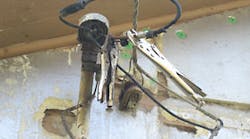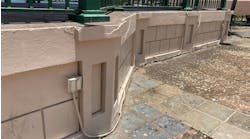Can you spot the Code violations?
Hint: Get a grip!
Find the Answer
How well do you know the Code? Think you can spot violations the original installer either ignored or couldn't identify? Here's your chance to moonlight as an electrical inspector and second-guess someone else's work from the safety of your living room or office. Can you identify the Code violation(s) in this photo?
November Winners
Our three winners this month were: Brian Newland, electrical engineer, Dulohery Weeks, Savannah, Ga.; Shawn E. Verzinskie, electrical designer, BALA Consulting Engineers, Inc., King of Prussia, Pa.; and Bill Geschwilm, electrical foreman, Pritchard Brown LLC, Baltimore, Md.
Here's a list of some of the Code sections they felt were in violation.
If this installation is located at a carnival, circus, fair, or other similar event, then it's in violation of 525.21(B), which states, “Electrical wiring for lighting, where installed inside of tents and concessions, shall be securely installed and, where subject to physical damage, shall be provided with mechanical protection. All lamps for general illumination shall be protected from accidental breakage by a suitable luminaire or lampholder with a guard.”
If this installation is classified as a temporary installation, then we can reference 590.4(F), which in part states, “All lamps for general illumination shall be protected from accidental contact or breakage by a suitable luminaire or lampholder with a guard.” Section 590.4(J) can also be noted for an improper means of support.
Other sections of the Code worthy of review include 400.7 and 400.8, which outline the uses and non-uses of flexible cords and cables.
‘TELL THEM WHAT THEY'VE WON…’
Using the 2008 NEC, correctly identify the Code violation(s) in this month's photo — in 200 words or less — and you could win something to put in your tool-box. E-mail your response to [email protected], and we'll select three winners (excluding manufacturers and prior winners) at random from the correct submissions. Winners will receive a set of insulated hand tools from Ideal Industries, Inc. valued at more than $125.* The set includes 9.25-inch insulated side-cutting pliers, 10-inch insulated tongue-and-groove pliers, and a 0.25-inch ? 6-inch insulated screwdriver.
* Please allow six to eight weeks for delivery of tools.



